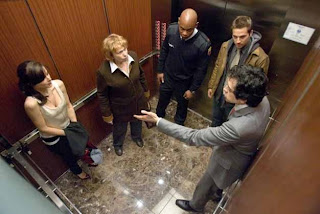
“From the mind of M. Night Shyamalan”. What more reason would you need to see Devil? After all, his filmography includes writing and directing such “classics” as The Village, Lady In The Water and The Happening, and added to that Signs, Unbreakable and the Sixth Sense, which all for the latter have audiences divided. There’s a story doing the rounds that an audience at a screening of Inception burst into laughter when they saw his name advertised during the trailer for Devil. Promotional advertising at its finest.
Just to clear it up, the story itself was conceived by Shyamalan, and adapted to a screenplay by Brian Nelson (who did the same job on both 30 Days of Night and Hard Candy), so things sound a little better when you search for the truth. More so when you realise it is directed by John Erick Dowdle, whose previous feature film was the decent Quarantine. Although that didn’t reach the heights of the original, it shows that there is potential in his work.
Devil is build up from a simple premise. Essentially an old wives tale, we are about to witness the "devil's meeting", where a group of people each with an evil heart the devil comes to haunt and eventually kill people who have sinned in the past. The logistics of this are explained throughout by narrator Ramirez (Jacob Vargas), a devout religious type, recounting the tale as it had been passed on by his mother as a youngster.
From the off we can see that Dowdle is going to offer something unexpected. In a nausea-inducing series of inverted shots, we enter a typical American city where we witness a suicide, in dramatic fashion. We are told by Ramirez that a suicide would initiate the coming of the devil, and all of his evil ways. Clearly this opening sequence heralds this, showing us the change in reality within his presence, and it is a visually astounding sequence.
We are introduced to our characters very early on, and all very quickly one after another, from the Detective who will obviously attempt to sort the issue out (a charismatic Chris Messina) to the generic fivesome that end up in the elevator itself. The five trapped individuals are given very generic in the credits, a mechanic, a guard, a salesman, a young woman and an old lady.. This is surely to make us feel as if we’re familiar with these everyday characters from or own lives, and it works well as we know what to expect. That is of course, until their dark pasts slowly make themselves known through the course of the film.
One of the features of Devil is the use of snappy and clever editing, utilised to great effect in providing some shocks throughout, but also in displaying the devil’s supernatural powers and the confusion that it causes to those watching. Included in this is the audience itself, as the tension is built up slowly. As well as this, the story develops well throughout, and it keeps us guessing as to what will happen next.
As the first film in the Night Chronicles, Night intends for the series to continue and subsequent films to be produced by his company Blinding Edge Pictures. He has said that “Ideas I didn’t get to direct for whatever reason and I can get amazingly talented filmmakers to come in and interpret them”, and as long as he stays away from egotistical scripting and directorial duties then we can all look forward to his second offering.
The credit for Devil should go to the people who wrote and directed it, and certainly not the producer who took the idea and the major plot twist from an Agatha Christie novel (And Then There Were None). It is short in length, but it feels just right as the characters are developed enough within that time, everything is explained very well throughout. Overall this is an accomplished piece of filmmaking even though it’s not perfect- the outcome in particular is too predictable, but that’s forgivable as the build up is executed quite well. Overall a simple concept, providing a sort of minimalistic horror film, to an extent.
Rating:
4/5




